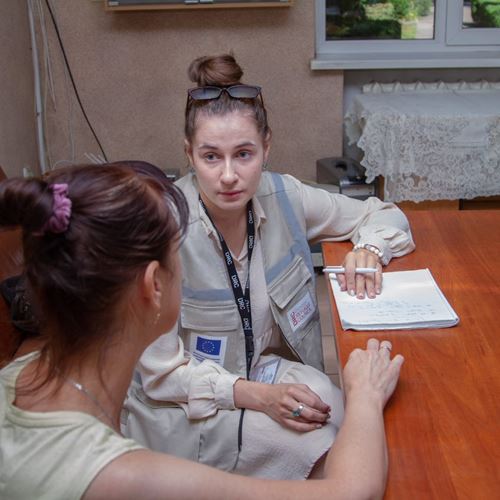News
Fleeing into the woods
Escaping areas hit by intense shelling for months in eastern Ukraine, 20 people find interim homes and peace of mind in a national park in western Ukraine where foresters are working to turn all extra space into desperately needed shelter for displaced.

It used to be students and researchers living in the houses attached to this national reserve in western Ukraine, but now the people hosted here are people who have had no other choice than to flee their homes and seek refuge and protection away from the battle zones in east and south of the country, as well as areas north-west of the capital Kyiv when it was under attack in the first weeks and months after 24 February 2022.
‘We are working hard to host as many people here as possible and we are working every day to find ways and means to expand even further,’ says Danchyyk Olek oversees the UNESCO protected bio reserve.
There are several houses in the reserve used earlier on by local Ukrainian universities from around the country who would send staff and students to spend time here. Now, all resources from organisations, charity and local goodwill are turned into use. Danchyyk Olek and the foresters here are trying to mobilse further support to restore the buildings and make them suitable for interim housing for more people and not least to prepare them for the winter, as some have been left empty for years.
A new purpose
Danchyyk Olek explains how they have entirely shifted their focus from running the national park, its exhibition spaces and animal sanctuary. In the past months, their time and resources are dedicated solely to efforts related to accommodating more people who they know so desperately need shelter, protection and not least time to recover from extreme stress and trauma.
‘Our exhibition would usually have school classes visiting, but now we can open our doors to children from among the displaced families. Similarly, our meeting room is used as a classroom – and all space we can avail is offered to some of the many people who need shelter right now.’
Some rooms and spaces need better water supplies, electricity, sewage, beds, some mattresses and basic facilities to be transformed into housing that can be offered. A storage room with a kitchen that used to be used for preparing food for wounded animals in the sanctuary is now home to a family from Kherson with fridge, table, chairs and toys for the children brought in by the local community near the national park.
‘We passed perhaps 30 checkpoints and saw many horrors and casualties on the road during our escape and shelling was constant, tells a man who is here with his wife, their son and the bird they managed to rescue.’
Many Ukrainians have managed to bring with them a few belongings, some ID papers and key documents, but also their pets. The boy in the family from Kherson carried during their journey a small cage with his bird named Gosha.
‘We feel very lucky to be here now, and to have found a place where we can breathe and be safe for now,’ says the father who managed to drive the family to safety across the country in their old car parked now in the outskirts of the national park.
Legal aid from DRC
A team of lawyers and protection expertise from DRC visits shelters hosting IDPs to offer legal guidance and when need be, referral to treatments and other services offer by local and international institutions. They explain to the new inhabitants in the national park how it is possible restore documents, what services they can expect since recent and constant changes to legislation in Ukraine, and how they can request for support and guidance in case of specific questions or needs.
The DRC mobile protection and legal aid teams are able to solve some requests right away and other cases needing more in-depth work and legal analysis are handled by the team right after. Legal aid to people on the move and in displacement are among the core activities offered by DRC across Ukraine – and key infrastructure hubs and locations where internally displaced are hosted.
A safe haven far from home
In another house, eight people are currently living in areas that have been turned into two separate apartments. The mother, a musical teacher, tells how they had little time to leave as shelling came close to their homes. They escaped and thought the place they managed to get to after hours on the road was safe. But some days later, they had to flee again.
‘My son is one year and eight months old and even though he is just a small child, he seems to understand all too well what is happening around us. When we arrived here at the national park, he was sitting next to the door for four days and wanted nothing but to go home.’
Right outside the window are pine trees and birds are singing. The reserve is a unique haven out of harm's way for the internally displaced and if they managed to raise enough funds, will be able to house another 100 people, meaning in total 120. Thise who have made their way here feel lucky, but they are longing for the time when they can return to their homes. A woman housed in the shelter, tells how she has been in touch recently with some of the people who stayed behind in the area she fled from, including the woman who owns the flat she lives in back home.
‘She has gone to see the place and told me that it looks fine. There are some damages there like everywhere else in the areas that have been shelled, but most of our things are there. And she told me that the flowers I keep inside the apartment are now blossoming.’
